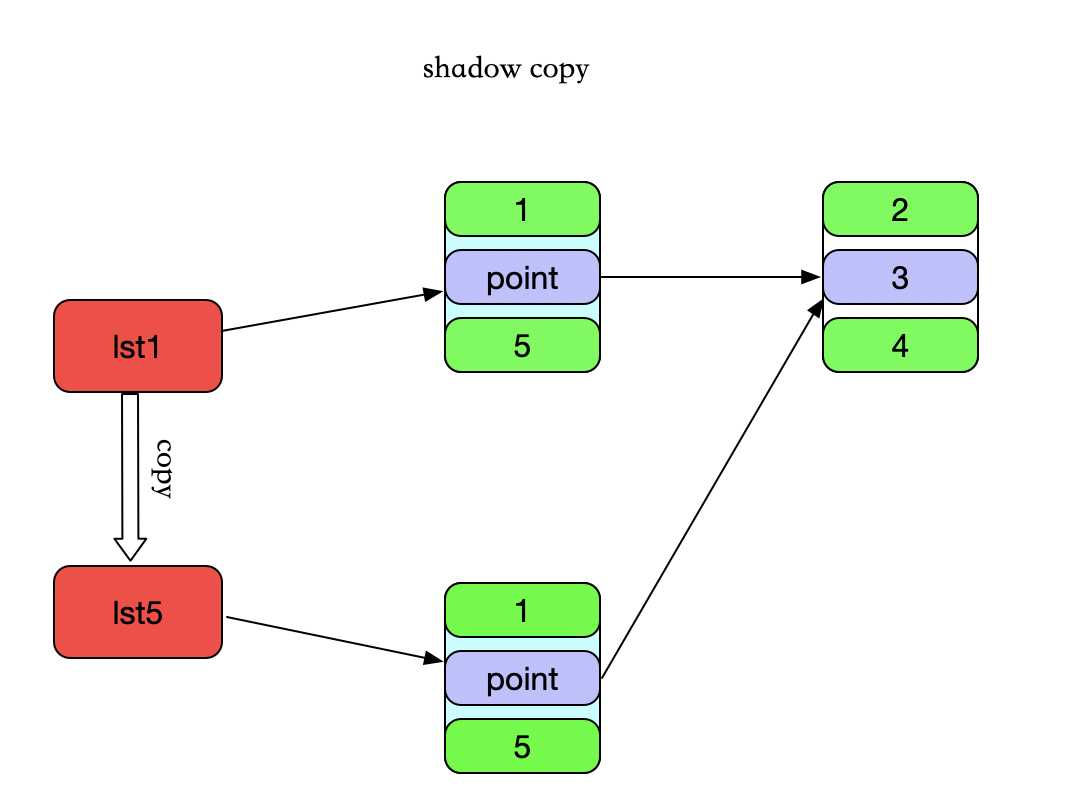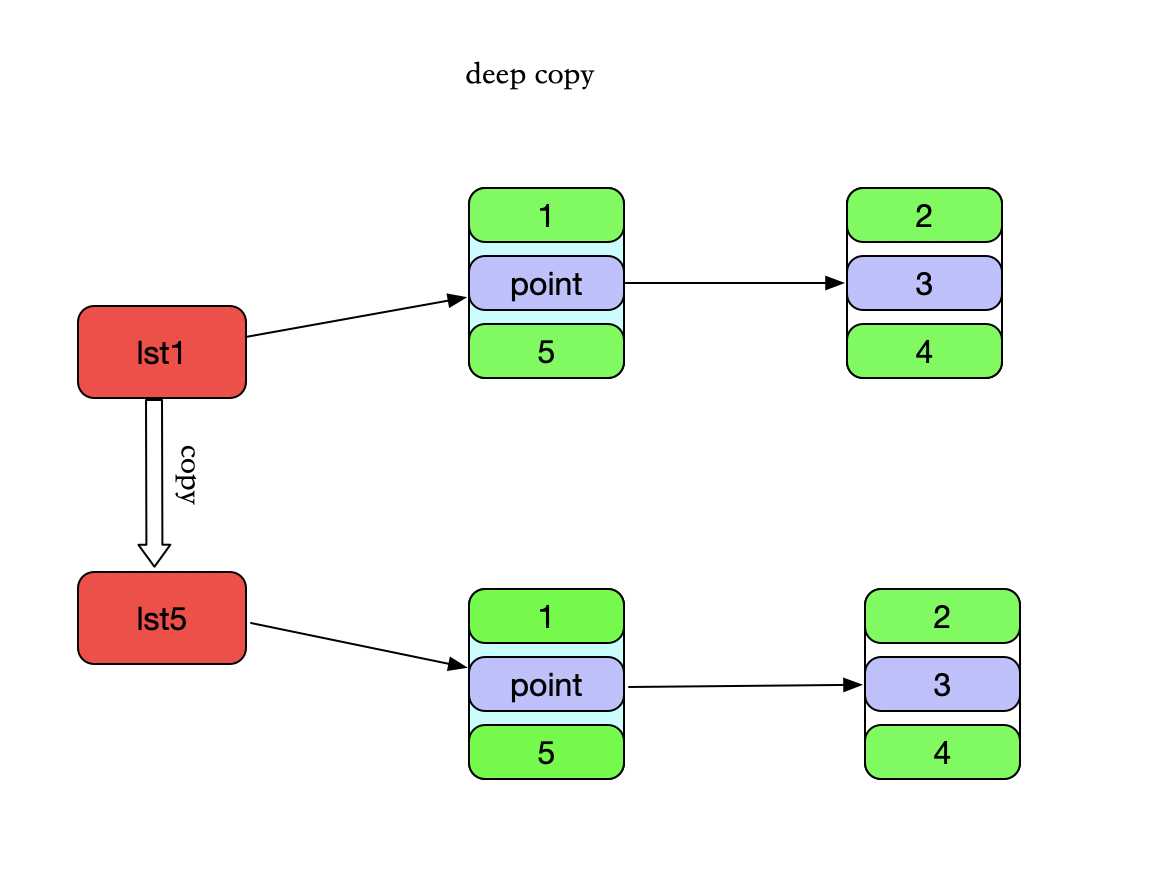python内置数据结构
时间:2019-05-28 15:09:34
收藏:0
阅读:117
数据类型:
数值型
- int
- float
- complex
- bool
序列对象
- 字符串 str
- 列表 list
- 元组 tuple
键值对
- 集合 set
- 字典dict
数值型:
- int、float、complex、bool都是class,1、5.0、2+3j都是对象既实例
- int:python3的int就是长整型,且没有大小限制、受限于内存区域的大小
- float:有整数部分和小数部门组成,支持十进制和科学计数法表示,只有双精度型。
- complex:有实数和虚数部分组成,实数部分和虚数部分都是浮点型。3+4.2j
- bool:int的子类,仅有2个实例True、False对应1和0,可以和整数值直接运算
类型转换:
- int(x) 返回一个整数
- float(x) 返回一个浮点数
- complex(x)、complex(z,y) 返回一个复数
- bool(x) 返回一个布尔值,前面讲过False等价对象
数字处理函数:
import math #向下取值,地板 print(math.floor(2.5),math.floor(-2.5)) #向上取值,天花板 print(math.ceil(2.5), math.ceil(-2.5)) #测试四舍六入五取偶 print(round(3.5), round(3.5001), round(3.6), round(3.3))
#判断类型,但会一个bool值
print(isinstance(6, str))
print(isinstance(6, (str, bool, int)))
- round(),四舍六入五取偶
- floor(),向下取整,ceil(),向上取整
- int(),取整
- // 取整且向下取整
- min() 最小值
- max() 最大值
- pow(x,y) 等于x**y
- math.sqrt() 平方函数
- bin(x) 二进制 返回值是字符串
- oct(x) 八进制 返回值是字符串
- hex(x) 十六进制 返回值是字符串
- math.pi π
- math.e 自如常数
类型判断
- type(obj) ,返回类型,而不是字符串
- isinstance(obj, class_or_tuple),返回一个bool值
序列对象
列表(list)
- 一个队列,一个排列整齐的队伍
- 列表内的个体称作元素,由若干元素组成列表
- 元素可以是任意对象(数字、字符串、对象、列表等)
- 列表内元素有顺序,可以使用索引
- 线性的数据结构
- 使用[]表示
- 列表是可变的
- 列表list、链表、queue、stack的差异
列表list定义
- list()
- list(iterable)
- 列表不能一开始定义大小
lst = list() lst = [] lst = [2,6,9,‘ab‘] lst = list(range(5))
列表索引访问
- 索引、也叫下标
- 正索引:从左到右,从0开始为列表中每一个元素编号
- 负索引:从右到左,从-1开始
- 正负索引不可以超界,否则引发异常IndexError
- 为了理解方便,可以认为列表是从左到右排列的,左边是头部,右边是尾部,左边是下界,右边是上界。
- 列表通过索引访问 list[index] ,index就是索引,使用中括号访问
列表查询
index(value,[start,[stop]])
- 通过值value,从指定区间查找列表内的元素是否匹配
- 匹配第一个就立即返回索引
- 匹配不到,抛出异常ValueError
count(value)
- 返回列表中匹配value的次数
时间复杂度
- index和count方法都是O(n)
- 随着列表数据规模的增大,而效率下降
如何返回列表元素的个数?如果遍历?如何设计高效?
- len()
列表元素修改
索引访问修改
- list[index] = value
- 索引不要超界
l = [1,2,3,4,5] l[3] = "jaxzhai" l
列表增加、插入元素
append(object) ->None
- 列表尾部追加元素、返回None
- 返回None就意味着没有新的列表产生,就地修改
- 时间复杂度是O(1)
insert(index,object) -> None
- 在指定的索引index处插入元素object
- 返回None就意味着没有新的列表产生,就地修改
- 时间复杂度是O(n)
- 索引能超越上下界吗?
- 超越上界,尾部追加
- 超越下界,头部追加
extend(iteratable) -> None
- 将可迭代对象的元素追加进来,返回None
- 就地修改
+ -> list
- 连接操作,将两个列表连接起来
- 产生新的列表,源列表不变
- 本质上调用的是_add_()方法
* -> list
- 重复操作,将本列表元素重复N次,返回新的列表
列表删除元素
remove(value) -> None
- 从左至右查找第一个匹配value的值,移除该元素,返回None
- 就地修改
- 效率慢(因为要查找这个值, 如果这个值是最后一个值,这时候已经遍历了一遍列表了)
pop([index]) -> item
- 不指定索引index,就从列表尾部弹出一个元素
- 指定索引index,就从索引处弹出一个元素,索引超界抛出IndexError错误
- 效率?不指定索引的话效率会高,指定索引的话效率会低
clear() -> None
- 清除列表所有元素,剩下一个空列表
列表其它操作
reverse() -> None
- 将列表元素反转,返回None
- 就地修改
sort(key=None,reverse=False) -> None
- 对列表元素进行排序,就地修改,默认升序
- reverse为True,反转,降序
- key一个函数,指定key如何排序
in
- [3,4] in [1,2,[3,4]]
- for x in [1,2,3,4]
列表复制
lst0 = list(range(4)) lst2 = list(range(4)) print(lst0==lst2) lst1 = lst0 lst1[2] = 10 print(lst0)
- lst0和lst2的内容是相等,内存地址不同。
- lst1和lst0的内容相等,内地地址也相同
copy() -> list
- shadow copy(浅拷贝)一个新的列表
浅拷贝
- 影子拷贝,遇到引用类型,只是复制一个引用而已。(例如列表,字典等。既引用同样的内存地址)

深拷贝
- copy模块提交了deepcopy

import copy lst0 = [1, [2, 3, 4], 5] lst5 = copy.deepcopy(lst0) lst5[1][1] = 20 lst5 == lst0 这个执行结果就是False
随机数
random模块
- randint(a,b) 返回[a,b]之间的整数
- choice(seq) 从非空的元素序列中随机挑选一个元素,例如:random.choice(range(10)),从0到9中随机挑选一个整数。
- randrange([start],stop,[step])从指定范围内,按指定基数递增的集合中获取一个随机数,基数缺省值为1。random.randrange(1,7,2)
- random.shuffle(lsit) -> None 就地打乱列表顺序。
- sample(population,k)从样本中随机取出k个不同的元素,返回一个新列表。
原文:https://www.cnblogs.com/xzkzzz/p/10863095.html
评论(0)
